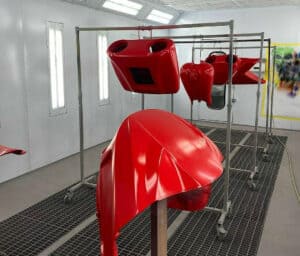How Solvent vs. Water-Based Paint Affects Color Matching
Any painter in the collision industry knows about the huge shift to water-based paints. They’re better for application, drying, and color matching than a traditional solvent coating. But as some shops continue to use this outdated method of refinishing, they could face the reality of becoming outdated themselves. The majority of automotive manufacturers utilize waterborne paints for their car colors, some even as elaborate as tri-coat and quad-coat specialty colors. In fact, this isn’t a new industry change; despite water-based paints still being a hot-button topic, automotive manufacturers have been utilizing this type of coating for nearly three decades.
So, why are there still some shops that haven’t made the change to a waterborne painting system? In this article, we breakdown why waterborne coatings are better for painting, drying, and color matching than solvent coatings.
 Is There Really a Difference?
Is There Really a Difference?
Waterborne paints have been used in the automotive manufacturing industry since the 1990s. Now fast-forward 33 years later to 2023, the U.S. Department of Transportation reported the average age of an automobile on the road is 12.5 years old, meaning nearly 100% of those vehicles were manufactured with waterborne paint. However, not all shops have followed their industry counterpart’s change, creating a huge difference in color matching newer vehicles vs older ones.
While any experienced painter will be able to color match no matter the type of coating being used, the results may not always come out the same. This is because solvent paints are more likely to experience defects than waterborne paints, including fading and discoloration. There is also more room for error when spraying with solvents than water-based coatings.
Spraying Water vs Solvent Coatings
The spray application is where the major differences show up between water and solvent coatings.
- Number of Applications: Water coatings typically need 1.5-2 applications whereas solvent coatings need up to 6 applications. This can save shops a ton of money by not going through as many paint cans and also by speeding up the painting process and turning out more jobs per day.
- Higher Quality Coatings: Waterborne paint offers a higher quality coating as they give more coverage for less product. They also dry incredibly faster than solvent-based coatings.
- Faster Drying Times: Since water dries through dehydration, it can dry incredibly faster than solvent coatings—sometimes even as quick as within 5 minutes, whereas solvent needs at least 30 minutes before top-coating.
- Less Room for Error: Not only does water dry incredibly faster than solvent, it dries more consistently and evenly. With solvents, it’s extremely difficult to visually see when it’s dry, whereas water becomes dry to the touch.
 Making the Switch to a Waterborne System
Making the Switch to a Waterborne System
While it is recommended, a booth running a solvent system doesn’t need to be retrofitted for water coatings. The Accudraft Xcelerator uses its own independent air supply, so it does need to use the shop’s compressed air. With 32 adjustable eyeball nozzles direct fast-moving 5-micron rated air at the job being painted, the Xcelerator can cut base coat drying times by up to 50%. Paired with LIVE, Accudraft’s cloud-based paint booth data monitoring system, any shop can better understand which booth is under-performing or turning out more jobs per day. It can be especially useful for MSOs that are running solvent and water systems to compare drying and total job times.
Improve Your Shop’s Performance
If you’re looking to improve your shop’s performance, contact Accudraft. Our team of experts can help retrofit your current booth to make the switch to a waterborne system. Whether it’s updating a current shop or opening a new location, we’re experienced with making the best finishing systems in the industry.